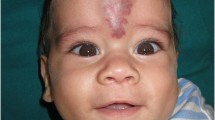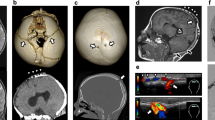Abstract
Sinus pericranii is a rare vascular abnormality characterised by abnormal connections between the intra- and extracranial venous systems and is usually found in children. In most instances, a sinus pericranii presents as a soft scalp swelling that appears with the patient in the recumbent position and disappears in the erect position. We review two cases of sinus pericranii presented in adulthood and treated surgically with good outcomes. We have performed a search of the English literature using the PubMed database and reviewed the published cases to date to present an overview of this pathological entity.





Similar content being viewed by others
References
Anegawa S, Hayashi T, Torigoe R, Nakagawa S, Ogasawara T (1991) Sinus pericranii with severe symptom due to transient disorder of venous return–case report. Neurol Med Chir (Tokyo) 31:287–289
Bollar A, Allut AG, Prieto A, Gelabert M, Becerra E (1992) Sinus pericranii: radiological and etiopathological considerations. Case report. J Neurosurg 77:469–472. doi:10.3171/jns.1992.77.3.0469
Carpenter JS, Rosen CL, Bailes JE, Gailloud P (2004) Sinus pericranii: clinical and imaging findings in two cases of spontaneous partial thrombosis. AJNR Am J Neuroradiol 25:121–125
Epstein JA, Epstein BS, Small M (1961) Subepicranial hydroma. A complication of head injuries in infants and children. J Pediatr 59:562–566
Gandolfo C, Krings T, Alvarez H, Ozanne A, Schaaf M, Baccin CE, Zhao WY, Lasjaunias P (2007) Sinus pericranii: diagnostic and therapeutic considerations in 15 patients. Neuroradiology 49:505–514. doi:10.1007/s00234-007-0211-7
Kaido T, Kim YK, Ueda K (2006) Diagnostic and therapeutic considerations for sinus pericranii. J Clin Neurosci 13:788–792. doi:10.1016/j.jocn.2005.07.025
Luker GD, Siegel MJ (1995) Sinus pericranii: sonographic findings. AJR Am J Roentgenol 165:175–176
Mastin WM (1885) IV. Venous blood tumors of the vault of the cranium communicating with the superior longitudinal sinus. Continued. Ann Surg 1:439–463
Mori K, Yoneda S, Handa H (1976) Posttraumatic subepicranial varix. Surg Neurol 5:337–339
Newton TH, Potts DG (1974) Angiography. Mosby, Saint Louis
Ota T, Waga S, Handa H, Nishimura S, Mitani T (1975) Sinus pericranii. J Neurosurg 42:704–712. doi:10.3171/jns.1975.42.6.0704
Rozen WM, Joseph S, Lo PA (2008) Spontaneous involution of two sinus pericranii - a unique case and review of the literature. J Clin Neurosci 15:833–835. doi:10.1016/j.jocn.2006.10.025
Sakai K, Namba K, Meguro T, Mandai S, Gohda Y, Sakurai M, Matsumoto Y (1997) Sinus pericranii associated with a cerebellar venous angioma–case report. Neurol Med Chir (Tokyo) 37:464–467
Stromeyer (1993) About sinus pericranii (translating of original 1850 text). Surg Neurol 40:3–4
Author information
Authors and Affiliations
Corresponding author
Additional information
Comments
Marc Sindou, Lyon, France
Because sinus pericranii is rare, knowledge on how to deal with these lesions is somewhat uncertain. As these abnormalities can be the source of cosmetic preoccupations or chronic disabling symptoms, such as local cephalalgia, headaches, bruits…, patients may be willing to have the lesion radically treated. Before deciding percutaneous occlusion or surgical resection with bony defect repair, it seems wise to explore the underlying intracranial venous circulation, at least with venous angio-MR, or better, with femoral DSA, to check the haemodynamics of the venous circulation. As a matter of fact, occlusion–resection should be avoided if the sinus pericranii is involved in the drainage of an “isolated” venous cerebral territory.
Rights and permissions
About this article
Cite this article
Akram, H., Prezerakos, G., Haliasos, N. et al. Sinus pericranii: an overview and literature review of a rare cranial venous anomaly (A review of the existing literature with case examples). Neurosurg Rev 35, 15–26 (2012). https://doi.org/10.1007/s10143-011-0325-6
Received:
Revised:
Accepted:
Published:
Issue Date:
DOI: https://doi.org/10.1007/s10143-011-0325-6




